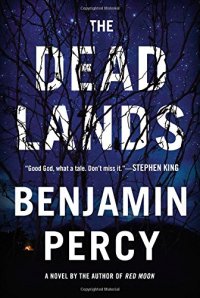
Published by Grand Central Publishing on April 14, 2015
In style and content, The Dead Lands strikes me as something Robert Jackson Bennett might have written. It is a mixture of science fiction and fantasy and steampunk and horror. It combines action and philosophy. It gives attention to character development without sacrificing plot. The prose reaches a level that is a notch or two above typical genre fiction. While the novel is not quite up to Bennett's level, it is considerably better than most of the abysmal writing that characterizes the current craze of post-apocalyptic fiction.
The world has changed since a pandemic combined with nuclear meltdowns to wipe out pretty much everyone before producing mutated species. The Mississippi riverbed is dry. Spiders and bats are even creepier than they used to be. The last human survivors (or so they believe) live in the Sanctuary, formerly known as St. Louis. It is an ordered society, with laws and farms and hospitals. Ordered but despotic; the mayor has made it a capital offense to criticize the mayor. Outside the walls, in the Dead Lands, there are only nightmares. Simon, a young thief who lives in the streets, watches as his father is marched beyond the walls and chained to a stone altar. Simon knows how to leave the walls but he is too late to save his father from the creatures that live in the woods.
In addition to Simon, the residents of the Sanctuary we meet include Lewis Meriwether, a cranky old guy who curates a museum and keeps track of other people's business with his mechanical owl. Mina Clark is among the few residents who thinks it would be better to die free, beyond the walls, than to die in service of the Sanctuary (although voicing that opinion would be to invite chaining to the altar). Her half-brother York is a juggler. When a little girl named Gawea rides up to the gate on a horse, the residents of Sanctuary know they are not alone.
Mysteriously, Gawea is bearing a letter for Lewis, telling him that he is not the only gifted person in the world. His gift is a form of telekinesis. Gawea's power has something to do with the birds and the bees, but not in a romantic sense. Anyway, Lewis and Clark go on a journey across America, chased by a man named Colter, heading toward a man named Aran Burr. Lewis leaves behind a teenage girl named Ella, charging her with taking care of the museum, one of many subversive tasks she undertakes with Simon's help.
Stories within stories unfold as Lewis and Clark make their journey -- their own stories, those of people they meet, and those of the people left behind in Sanctuary. Stories of adventure, enslavement, and survival. Humans are capable of wonderful things, Lewis opines, but more often they excel at ruin. The reader encounters plenty of that in The Dead Lands. Still, the story conveys a message of hope.
The underlying basis for all of this (the pandemic and the effects of untended nuclear plants) is explained only in a cursory fashion, which might be the novel's biggest fault. The cause of the apocalypse and the mutations are not very convincing, but that's common in post-apocalyptic fiction. At least, to my great relief, there are no zombies in this world.
The novel is self-contained but revelations at the end imply that further adventures are forthcoming. I suspect they will be worth reading. The Dead Lands will probably be too slow for readers addicted to zombie fiction, but readers who appreciate literary value should give it a try.
RECOMMENDED